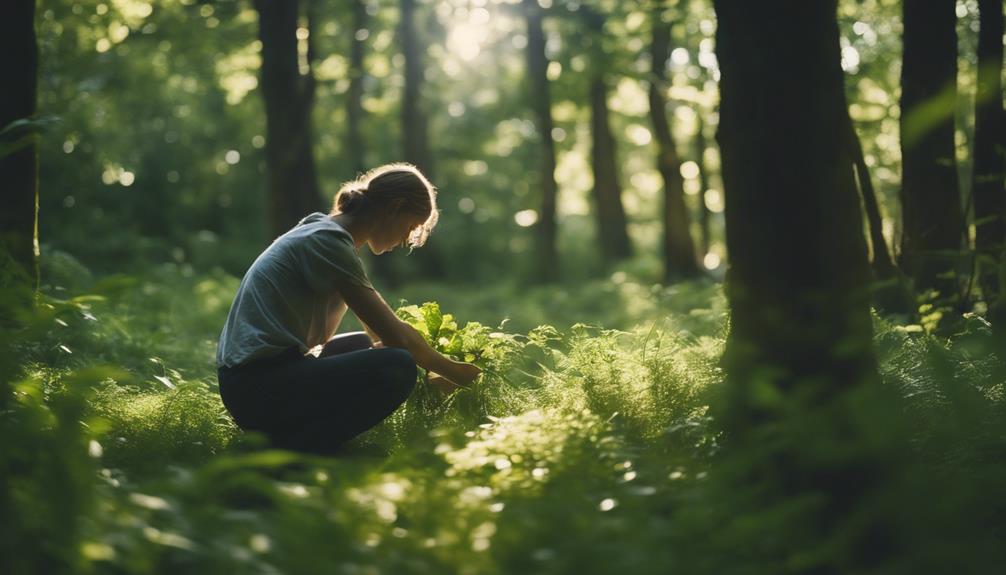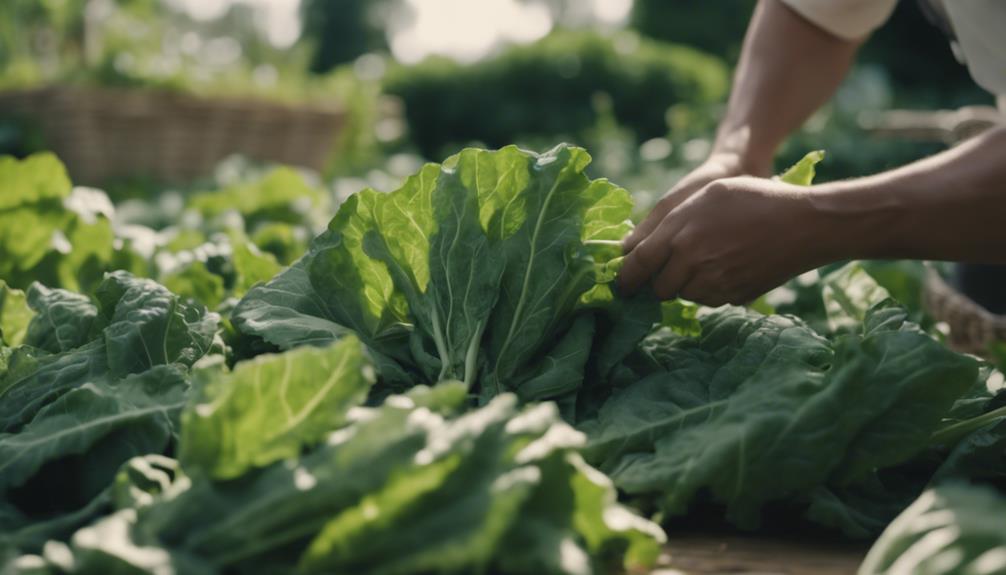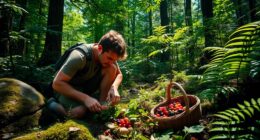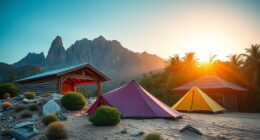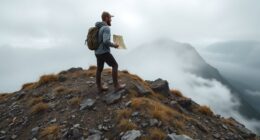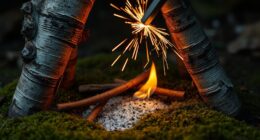When you go forest foraging, it's important to be responsible and respectful! Always pick just a little, about 5-10%, to help plants stay healthy. Avoid endangered plants and remember to ask if you're foraging on someone else's land. Keep an eye on your surroundings by choosing clean areas away from roads to stay safe. It's also a great idea to know what's edible and what isn't, so you can enjoy your finds without worries. By being careful and aware, you'll have a fun experience! Stick around, and you'll discover even more exciting tips for your next adventure!
Key Takeaways
- Always harvest responsibly by taking only 5-10% of a plant population to ensure sustainability and avoid overharvesting.
- Seek permission before foraging on private property and respect the "Leave No Trace" principle to protect the environment.
- Familiarize yourself with local foraging regulations and choose safe locations, avoiding areas near roadsides or industrial sites.
- Keep a foraging notebook to document plant characteristics, preparation methods, and personal experiences for future reference.
- Engage with local foraging groups to learn from experienced foragers and foster community connections through collaborative foraging activities.
Foraging Ethics and Responsibilities

When you're foraging in the wild, it's essential to keep ethical considerations at the forefront. Responsible foraging means thinking about how your actions affect plant populations and wildlife. Stick to a harvesting limit of 5-10% to guarantee sustainability and let nature regenerate.
Remember, some plants are local endangered species, so avoid picking anything rare or protected.
Always ask for permission before foraging on private property. Respecting landowner preferences helps maintain good community relationships.
When you forage, practice the principle of "Leave No Trace." This means you should avoid trampling on surrounding plants and make certain to take all your waste with you.
Connecting with local foraging communities can also widen your understanding of foraging ethics. Learning from others can help you appreciate wild food resources even more!
By engaging with experts, you'll discover how to enjoy nature while caring for it. So, when you set out to forage, think about the impact on the environment and the community.
Additionally, understanding sustainable foraging practices is crucial for maintaining ecosystem health and ensuring resources are available for future generations.
With these tips, you can forage responsibly and enjoy nature's bounty while protecting it for future generations!
Best Harvesting Practices

To make the most of your foraging experience, it's crucial to adopt best harvesting practices that prioritize sustainability and respect for nature. When you're out searching for wild edibles, remember to gather only what you need. Stick to the recommended limit of 5-10% of a plant population, ensuring that the plants can grow back and thrive. This is key for sustainable harvesting! Incorporating protein-packed seeds into your diet can also be a great way to supplement your foraged finds. Using energy-efficient methods can also help minimize the environmental impact of your foraging activities. Additionally, many regions, such as Minnesota, offer a variety of wild edibles that are perfect for foraging.
Utilizing non-perishable items can also be beneficial for those who want to preserve their foraged goods for later use. Use gentle techniques when you're picking edible wild plants. Careful harvesting helps minimize damage not just to the plants you're after, but also to surrounding native plants. Remember, you don't want to trample on plants that aren't being harvested. This keeps our ecosystems healthy and vibrant!
Be cautious, especially when harvesting leaves, shoots, roots, and tubers. These parts need extra care to avoid long-term damage. Additionally, understanding local regulations regarding foraging is essential for responsible harvesting practices. In Michigan, for instance, there are over 300 species of edible plants that require proper identification to avoid toxic varieties.
Keep an eye on the plant population, and if it looks low, adjust your harvesting techniques. This shows responsible stewardship of the environment, making sure there's enough for everyone—both today and in the future.
Happy foraging!
Identifying Safe Locations

Choosing safe locations for foraging is essential to guarantee both your safety and the sustainability of the ecosystem. You want to find spots where you can identify edible species without worrying about poisonous plants or chemical contamination. Look for areas away from roadsides, industrial sites, and places that use pesticides. Always ask for permission if you're foraging on private property, and respect the landowner's wishes. Familiarizing yourself with local regulations is also vital, as some areas have specific rules. Additionally, being aware of personal debt forgiveness bills can help you manage any financial burdens that may arise during your foraging activities. It's also wise to monitor pet health if you're foraging in areas where you might encounter ticks, as they can pose a risk to both you and your pets. While foraging, consider the impact of wood-burning on deforestation and climate change, as it can affect the health of the ecosystem where you are foraging. Regularly checking air quality indices can aid in identifying less contaminated areas for foraging, enhancing both your safety and the quality of foraged goods. Utilizing HEPA filters in your home can also improve indoor air quality, which is important for your overall health while foraging outdoors.
Here's a quick reference table to help you choose safe foraging spots:
| Safe Locations | Unsafe Locations |
|---|---|
| Community gardens | Roadsides |
| Nature reserves | Industrial sites |
| Forests away from farms | Agricultural lands |
| Monitored parks | Old orchards |
| Clean, flowing water sources | Contaminated water sources
Common Foraging Mistakes

Foragers often make critical mistakes that can jeopardize both their safety and the environment. One big mistake is overharvesting. If you take too much from a wild plant population, it can harm the environment, so remember to only take 5-10% of what you find. Additionally, maintaining a diversification strategy in your foraging practices helps ensure that you don't deplete any single species. In the same way, tiny house living emphasizes minimalism and sustainability, which can inspire foragers to be more mindful of their impact. It's also important to note that some foraged items, like certain plants, can have gastrointestinal side effects if consumed improperly.
Another important rule is to never eat any wild food until you can positively identify it. Use field guides to help you confirm that what you've found is edible and not toxic.
Planning is also key! Foraging in contaminated areas, like roadsides or near factories, can expose you to harmful chemicals. Always scout for clean spots, as toxins may accumulate in wild plants, affecting your health.
Plus, don't forget about permission! If you're on private land, you need to get the landowner's okay before foraging, or you might accidentally trespass. Additionally, being mindful of environmental sustainability is crucial to ensure that foraging practices do not negatively impact local ecosystems.
Resources for Foragers

Finding reliable resources is essential for anyone diving into the world of foraging. You want to make sure you can safely eat wild edible plants, and knowing which plants and fungi are good and which are potentially poisonous is vital. Here's a helpful table to guide you:
| Resource | Type | Purpose |
|---|---|---|
| Eat the Weeds | Website | Offers guides on edible plants and uses |
| Forager's Harvest | Book | Detailed plant identification and advice |
| Foraging Groups | Community | Connects you with experienced foragers |
It's a good idea to invest in books like "Midwest Foraging" or take online courses like "Foraging North America." These resources can help you become able to identify plants accurately. Engaging in foraging activities can also promote social interaction and enhance your appreciation for nature. Joining local foraging groups also lets you learn from others and share experiences. Additionally, many foragers find that the practice of foraging can help them develop a deeper connection with the outdoor structures around them. While reading this article, think about keeping a foraging notebook. Document your adventures, noting plant characteristics and preparation methods. This personal resource will make your foraging outings even more fun and informative! Additionally, understanding poisonous plants is crucial to avoid potential health risks while foraging.
Frequently Asked Questions
What Is the 1 3 Rule for Foraging?
The 1-3 Rule for foraging means that whenever you pick one plant or mushroom, you should leave at least three behind.
This way, you help nature stay healthy! It's like sharing your toys with friends; if everyone took everything, there wouldn't be enough left for anyone.
How to Forage Respectfully?
When you're out foraging, think of it like sharing a secret with nature.
To forage respectfully, always ask permission if you're on private land. Take only a little from each plant, like picking just a few berries from a bush, to keep nature thriving.
Watch your step, too! Leaving no trace means taking your trash with you, so the forest stays beautiful for others and the wildlife.
Happy foraging!
What Is the Golden Rule of Foraging?
The golden rule of foraging is simple: only take what you need!
This means you should leave enough for wildlife and the plants to keep growing. Imagine picking a few delicious berries but leaving most behind for animals and future foragers.
By doing this, you're helping nature stay healthy and happy. It's all about sharing and caring, so everyone can enjoy the wild goodies for years to come.
Happy foraging!
What Are Three Cautions Regarding Foraging?
When you're out foraging, there are a few important things to keep in mind!
First, always make sure you know exactly what a plant is before tasting it, since some can be harmful.
Next, be careful not to take too much; leave enough for wildlife and other foragers.
Finally, check if you're allowed to forage in that area, so you don't accidentally trespass.
Happy exploring, and enjoy nature safely!
Conclusion
So, whether you’re hunting for mushrooms like a treasure-seeking pirate or gathering berries like a happy squirrel, remember to respect nature and follow the rules! Always leave enough for others and take only what you need. With these tips, you’ll become a fantastic forager in no time! So grab your basket, explore the great outdoors, and enjoy the delicious bounty nature has to offer. Happy foraging, and may your adventures be filled with yummy finds! If you’re new to foraging, consider picking up a beginner’s guide to mushroom foraging to help you identify safe and edible species. It’s important to educate yourself on the potential dangers of consuming wild mushrooms and to always err on the side of caution. By doing so, you can ensure a safe and successful foraging experience. Happy hunting!





